Pathways: A Story of Trails and Men (1968), by John W ... - Yosemite
Pathways: A Story of Trails and Men (1968), by John W ... - Yosemite
Pathways: A Story of Trails and Men (1968), by John W ... - Yosemite
- No tags were found...
You also want an ePaper? Increase the reach of your titles
YUMPU automatically turns print PDFs into web optimized ePapers that Google loves.
The Army <strong>of</strong>ficer in charge acted as the superintendent <strong>of</strong> the park. The troops would arrive in May <strong>and</strong> leave in October, returning to thePresidio <strong>of</strong> San Francisco. Captain A. E. Wood was in comm<strong>and</strong> <strong>of</strong> the first troops assigned to <strong>Yosemite</strong>. Captain Wood, in comm<strong>and</strong><strong>of</strong> two troops <strong>of</strong> Cavalry, Companies I, <strong>and</strong> K, arrived in <strong>Yosemite</strong> May 19, 1891, <strong>and</strong> set up camp at Wawona.“Starting from Wawona, there was a main trail leading through Crescent Lake, <strong>John</strong>son Lake, Gravelly Ford, thence <strong>by</strong> Little GraniteCreek, 77 Corral, Devils Post Pile, <strong>and</strong> so on to the east <strong>by</strong> Mammoth Pass, thence from Devils Post Pile running north through AgnewsPass via Parker Glacier to Bloody Canyon, thence into Nevada.“A second trail led north from the east end <strong>of</strong> <strong>Yosemite</strong> Valley through Sunrise Meadow <strong>and</strong> past Cathredral Peaks, <strong>and</strong> throughTuolumne Meadows, <strong>and</strong> so on north to Mt. Conness, where the State Observatory was for many years.“Then a small branch road led from Crockers on the Big Oak Flat road via the Tioga Road at Ackersons Ranch to the Hog Ranch. Fromthe Hog Ranch a well known trail led to the Hetch Hetchy Valley. From Hetch Hetchy a trail led to Lake Eleanor. Also a trail led fromthe Hog Ranch via Poopenant Valley to Lake Eleanor.“A main trail also led north from Wawona to Glacier Point, crossing the Chinquapin Road at Peregoy’s Meadow, to Glacier Point witha branch leading to the northeast <strong>by</strong> Mono Meadows <strong>and</strong> Illilouette Creek to Nevada Falls, connecting with the Sunrise Trail to theTuloumne River <strong>and</strong> Mt. Conness.“Other than these there were no marked or defined trails. Lt. McClure, with Corporal Sadlier in charge, made in June 1895, a trip fromCamp A. E. Wood, via <strong>John</strong>son Lake, Jackass Meadow <strong>and</strong> Granite Creek, <strong>and</strong> there, getting some sheep herders, had them conducthis detail over a pass named <strong>by</strong> him, Isberg Pass, to the McClure Fork <strong>of</strong> the Merced River, thence northeast <strong>by</strong> Tuolumne Pass, <strong>by</strong>Rafferty Creek, named <strong>by</strong> him after Doctor Rafferty, who was the surgeon <strong>of</strong> the detachment, to the Lyell Fork, thence <strong>by</strong> trail shown<strong>by</strong> Dingley Creek, Conness Creek, Alkali Creek, <strong>and</strong> up Spiller Canyon, across Matterhorn Canyon to Slide Canyon, thence down SlideCanyon to Great Slide up to Rock Isl<strong>and</strong> Lake, to Arndt Lake, thence down the Rancheria to Hetch Hetchy Valley, <strong>and</strong> so back toCamp Wood. He stated, “In the years during his scouting over the mountains, 1895, 6, 7, 9, 1902, 4 <strong>and</strong> 5, with every detail, that I tookout, each member <strong>of</strong> the detail carried a h<strong>and</strong> hatchet, hung from the saddle <strong>by</strong> a leather boot, <strong>and</strong> whenever there were trees, blazingwas done, <strong>and</strong> where there were no trees, the blazing was done <strong>by</strong> placing rocks along the route, the rocks being close to be able tobe seen from one to another.”During 1905, 6, 7, <strong>and</strong> 8, Benson had trails constructed around the entire Park <strong>by</strong> contract. The Interior Department furnished from eightto ten thous<strong>and</strong> dollars per year for this purpose. At the time <strong>of</strong> the U.S. Army’s taking charge <strong>of</strong> <strong>Yosemite</strong> Park, the entire country north<strong>and</strong> east <strong>of</strong> the <strong>Yosemite</strong> Valley was unknown country, except to sheepherders. The sheepherders had divided the country up amongthemselves, <strong>and</strong> certain canyons were known as the ranges belonging to certain men, <strong>and</strong> they drove out or killed any sheep herderswho attempted to trespass in their particular canyon or on their particular mountains.Outside <strong>of</strong> the valley, <strong>and</strong> the valley <strong>of</strong> the Hetch Hetchy, there was not a fish in any <strong>of</strong> the waters inside the park except in Lake Eleanor,where Mr. Kibbie a homesteader at Lake Eleanor had brought in some fish <strong>and</strong> planted them in 1877.The California Fish Commission built a hatchery at Wawona in 1893 <strong>and</strong> distributed fish in <strong>and</strong> about Wawona. The U.S. FishCommission had sent some fish down to Captain Wood at Camp A. E. Wood in 1891 <strong>and</strong> 92, <strong>and</strong> the planting <strong>of</strong> these fish in smallstreams in that vicinity furnished the hatchery with eastern brook trout. From time to time Benson netted out young fish <strong>and</strong> transportedthem further out into the mountains continuously until 1909. The amount <strong>of</strong> labor expended <strong>by</strong> Captain Benson <strong>and</strong> his details inimproving the trails was very great. The successful working out <strong>of</strong> the trails <strong>and</strong> the continuation <strong>of</strong> developing them are due largelyto the loyalty <strong>and</strong> efficiency <strong>of</strong> the Army <strong>of</strong>ficers in the field.So far as the development <strong>of</strong> trails <strong>and</strong> the policing <strong>of</strong> <strong>Yosemite</strong> Park <strong>by</strong> troops were concerned, very little was done during the firsttwo or three years that the park was occupied <strong>by</strong> the troops, that is, before the arrival <strong>of</strong> Troop K, 4th Cavalry, under Captain Alex<strong>and</strong>erRodgers. This is accounted for <strong>by</strong> the fact that Captain A. E. Wood, who was first in charge <strong>of</strong> the Park, suffered dreadfully <strong>and</strong> eventuallydied from cancer <strong>of</strong> the tongue. He was desperately ill himself <strong>and</strong> suffered the tortures <strong>of</strong> the damned. He kept one <strong>of</strong> the <strong>of</strong>ficers, Lt.Nolan, constantly with him, so there was very little opportunity for any work being done beyond the Tuolumne River. With the arrivalhowever, <strong>of</strong> Captain Rodgers things took on a different aspect. No sheep herders had been interfered with whatever up to 1895; in fact,the Comm<strong>and</strong>ing Officer in 1894 had permitted sheep to range over the immediate territory between Wawona <strong>and</strong> <strong>Yosemite</strong> Valley. Theresult was that no sheepmen had any idea <strong>of</strong> complying with the regulations which required them to keep outside the limits <strong>of</strong> the Park.Captain Wood devoted the main attention <strong>of</strong> his troops under Lt. Milton F. Davis to keeping cattle, mainly those <strong>of</strong> the Curtin, <strong>and</strong>Cattle Company, controlled <strong>by</strong> J. B. Curtin, from trespassing upon the park. When, however, Captain Rodgers, with Troop I <strong>of</strong> the 4thCavalry, took charge <strong>of</strong> the Park, a new era was instituted. During the next three years he waged incessant war against all trespassers,both cattlemen <strong>and</strong> sheepmen. Up to this time no trails had been developed, except the main trails which were already in existence,as indicated in a previous note.Almost all <strong>of</strong> the trails that were developed within the next three years were developed <strong>by</strong> Captain Benson. When a detail was out.inspecting the mountains, as soon as the days march was over <strong>and</strong> evening meal finished, Benson would start out over the country onfoot <strong>and</strong> prospect in the vicinity <strong>of</strong> the camp for several miles around. In this way he became acquainted with the mountains <strong>and</strong> streams.He had been trained to track in his Army training. He would find a trail <strong>of</strong> the sheep herders who were taking supplies out to the herdsalready in the mountains. Once a month supplies were carried out on mules to the sheep herders who, accompanied <strong>by</strong> goats <strong>and</strong> burros,were in the mountains with their herds. The owners packed out once a month, to some point previously agreed upon, the rations whichwere to last during the next few weeks. By getting on the trail <strong>of</strong> these big pack animals Benson followed them through the mountains,blazing trees as he went, until he came upon herds <strong>of</strong> sheep. Immediately on getting to these sheep herders, he had the sheep turned overto a few <strong>of</strong> the soldiers. Then Benson took all the herders <strong>and</strong> made them lead him out <strong>by</strong> another route, which he blazed, so that he wasable at once to get through that part <strong>of</strong> the country without difficulty. Benson was the only <strong>of</strong>ficer with the comm<strong>and</strong> who did this sort<strong>of</strong> thing <strong>and</strong> hence was practically <strong>and</strong> only man, except Captain Rodgers, who ever caught any herders. In so doing he was able to getinto the northern part <strong>of</strong> the Park, <strong>and</strong> <strong>by</strong> prospecting on foot <strong>and</strong> blazing the w’ay he was able to make trails covering that part <strong>of</strong> the




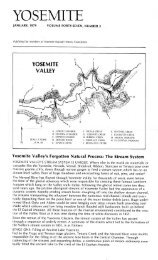
![(March 1982) [PDF] “We Are Pleased to Announce†- Yosemite Online](https://img.yumpu.com/51299748/1/190x242/march-1982-pdf-aeuroewe-are-pleased-to-announceaeur-yosemite-online.jpg?quality=85)
![[PDF] Old Horny, Yosemite's Unicorn Buck - Yosemite Online](https://img.yumpu.com/51269869/1/184x260/pdf-old-horny-yosemites-unicorn-buck-yosemite-online.jpg?quality=85)
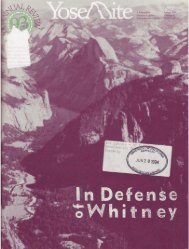
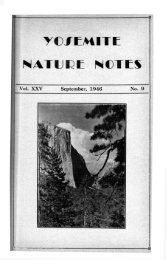
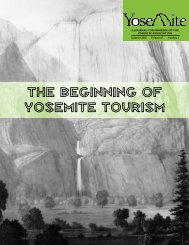
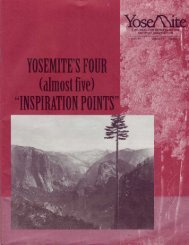
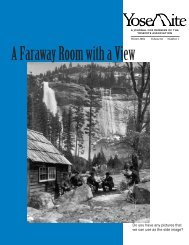
![1985 [PDF] - Yosemite](https://img.yumpu.com/48128837/1/184x260/1985-pdf-yosemite.jpg?quality=85)



